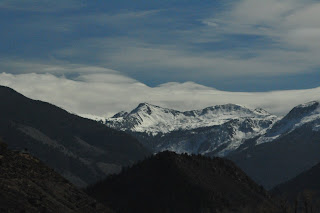The first pictures are of the mountains surrounding
Springville, UT. It did snow yesterday. My friend Debbie and I were planning to get together for lunch on Sunday, but it was cold and we were both warmly caved up and decided we will see one another when we get t0
Las Vegas in February. I have photos of the signs at some of the vista views in Utah and, since it is difficult to read them, I typed out the narratives next to the photos below.





After leaving
Springville this morning, I traveled south on I-15 to US Highway 50. Along Hwy 50 I saw so many beautiful sights with no place to pull off the road to take pictures - again! I need to make that drive one day in the car as there were a few places to pull off that would have worked had I been driving the car. There was snow along the sides of the road when I got up to about 5000 feet elevation and the clouds and snow on the Wasatch Mountains would have made some great pictures.

Along I-70, the roadsides are wide enough to pull off to take pictures and there were several off road view sites for travelers to take photos of the mountains and valleys formed by wind and water.
The mountain to the southeast, San Rafael Knob, is 7,921 feet above sea level, the highest point in the San Rafael Swell. This deep canyon is Devil's Canyon. It cuts throuth the Carmel
Formation, made of limestone and sandstone deposited in a sea that has been gone for 180 million years. The dramatically long and steep slopes below the Carmel are formed of Navajo sandstone, a formation prevelant throughout the Colorado Plateau, forming the spectacular views throughout Utah and Colorado. You are still ascending the west side of the rock dome that is the San Rafael Swell.
An anticline of huge proportions, the Swell was formed when forces below pushed up layers of rock below the earth's crust. Erosion has worn down the overlaying layers, forming the canyons, pinnacles and peaks you see here and as you drive further east. (I cut off the rest when I took the photo. Sorrrryyyyy!)


It takes rocks, water and time to make a landscape like this. Around here, rocks and water make great state parks, too, and there are four of them in San Rafael Country. With a little time, you can explore them all. Weird rock creatures seem to inhabit Goblin Valley State Park, 71 miles southeast of here(take the
Hanksville Exit). The strange formations are great for kids to climb and hike around. Green River State park and Golf Course, just 45 miles east, is the put-in point for river trips through Labyrinth and
Stillwater Canyons and is a base for seeing San Rafael County. When Traveling west through the Swell, you might detour to
Millsite State Park and Golf Course for a round of golf or an afternoon of fishing. Farther north, you can enjoy a bit of boating, water skiing, and fun at beautiful Huntington State Park. Each park offers modern restrooms, shower facilities, and group use sites. For reservations and information, call 1-800-322-3770 or 1888-564-3600.


Humans have lived among these rocks and cliffs for longer than you can imagine. Archeological investigations conducted as part of the interstate construction across the Swell during the 1970s and 1980s located over a hundred prehistoric sites. The sites show that hundreds of generations of Native American peoples inhabited this rugged land for thousands of years and in all seasons. Archeologists explored sites from the early Archaic period of hunting and gathering about 9,500 years ago, up to historic ranching sites of the early 20th century. People survived by hunting and gathering until about the time of Christ, when small-scale agriculture, dependent on corn, beans and squash, was adopted. Archeological remains of these farmers, whom we call Fremonts, include small settlements of pit dwellings, granaries, outdoor shaded work areas, hearths, storage pits,and trash mounds. The earliest evidence of farming in the Swell dates to about A.D. 500 at the Confluence Site. This site provided important insight into the transition from hunting and gathering to agriculture in the region, and predated previously known agricultural sites by 200 years. Bows and arrows and ceramics were the technological innovations of this time. Researchers found Fremont sites in the Ghost Rocks area, a few miles east of here, which is an upland environment and not well suited for growing corn. Study of the sites told archeologists much about the Fremont way of life, which included hunting and gathering year-round and farming at lower elevations along riverbanks.

 Maroon Bells at sunset.
Maroon Bells at sunset. The third picture is Jamie Lee taking pictures. The fourth picture is Jamie Lee and her mom having a good laugh.
The third picture is Jamie Lee taking pictures. The fourth picture is Jamie Lee and her mom having a good laugh.

 Maroon Bells at sunset.
Maroon Bells at sunset. The third picture is Jamie Lee taking pictures. The fourth picture is Jamie Lee and her mom having a good laugh.
The third picture is Jamie Lee taking pictures. The fourth picture is Jamie Lee and her mom having a good laugh.






 Colorado has some of the most beautiful scenery in the US!! Tracey, Jamie and I have been exploring the western parts of the state while James and TC have been hunting elk near the town of Rifle, Colorado. The blogs won't be in chronological order, but by the time I'm done, together, we'll have a good look at the wonderful sights. On Tuesday, the 21st, we got up early to go to Aspen because we thought the storm would be gone and we would get some good pictures in Aspen and at Maroon Bells. Hmmmmm.....think we were just a bit off. About 12 hours or so.
Colorado has some of the most beautiful scenery in the US!! Tracey, Jamie and I have been exploring the western parts of the state while James and TC have been hunting elk near the town of Rifle, Colorado. The blogs won't be in chronological order, but by the time I'm done, together, we'll have a good look at the wonderful sights. On Tuesday, the 21st, we got up early to go to Aspen because we thought the storm would be gone and we would get some good pictures in Aspen and at Maroon Bells. Hmmmmm.....think we were just a bit off. About 12 hours or so.






